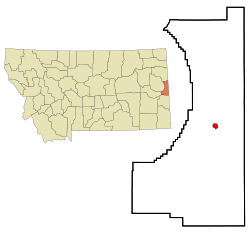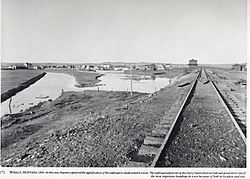Wibaux, Montana facts for kids
Quick facts for kids
Wibaux, Montana
|
|
|---|---|

Main Street in Wibaux
|
|

Location of Wibaux, Montana
|
|
| Country | United States |
| State | Montana |
| County | Wibaux |
| Named for | Pierre Wibaux |
| Area | |
| • Total | 1.07 sq mi (2.78 km2) |
| • Land | 1.07 sq mi (2.78 km2) |
| • Water | 0.00 sq mi (0.00 km2) |
| Elevation | 2,654 ft (809 m) |
| Population
(2020)
|
|
| • Total | 462 |
| • Density | 430.57/sq mi (166.26/km2) |
| Time zone | UTC-7 (Mountain (MST)) |
| • Summer (DST) | UTC-6 (MDT) |
| ZIP code |
59353
|
| Area code(s) | 406 |
| FIPS code | 30-80350 |
| GNIS feature ID | 2413483 |
Wibaux (/ˈwiːboʊ/ WEE-boh) is a small town located in Montana, a state in the United States. It is the main town and county seat of Wibaux County. Wibaux is the only official town in the county. In 2020, about 462 people lived there.
Contents
Town History

Before it was called Wibaux, the town had other names like Keith, Beaver, and Mingusville. The name Mingusville came from Minnie and Gus Grisy, who ran the local Post Office in the late 1800s.
In 1895, the town was renamed Wibaux. This was to honor Pierre Wibaux, a very important local cattle rancher. He moved to the area from France in 1883. Pierre Wibaux became successful by buying cattle from other ranchers who were having a harder time.
After Pierre Wibaux arrived, the town became a major center for shipping cattle. The Northern Pacific Railroad used Wibaux to transport many cattle. Even cattle from Theodore Roosevelt's famous ranches, like Maltese Cross and Elkhorn, near Medora, were shipped from here. In the 1880s, huge cattle drives from Texas to the northern grazing lands often passed through Wibaux.
A famous story involves Theodore Roosevelt in Wibaux (when it was still Mingusville). In 1884, shortly after he moved to the North Dakota Badlands, he had an encounter with a bully at Nolan's Hotel. Roosevelt, who would later become president, stood up to the man.
Geography of Wibaux
Wibaux is right on the border between Montana and North Dakota. It covers an area of about 1.08 square miles, and all of it is land.
A stream called Beaver Creek flows through the town. This creek is known for having large fish like walleye and Northern Pike. The area around Wibaux is also home to many animals. You can find deer, beavers, wild turkeys, and antelope living there.
Wibaux Climate
Wibaux has a cold semi-arid climate. This means it's usually dry, but not a desert. It has hot summers and cold winters. The hottest temperature ever recorded in Wibaux was 110 degrees Fahrenheit (43 degrees Celsius). This happened on three different dates: August 1, 1918, May 29, 1919, and August 7, 1949. The coldest temperature ever recorded was a very chilly -55 degrees Fahrenheit (-48 degrees Celsius) in January 1916.
| Climate data for Wibaux, Montana, 1991–2020 normals, extremes 1895–2021 | |||||||||||||
|---|---|---|---|---|---|---|---|---|---|---|---|---|---|
| Month | Jan | Feb | Mar | Apr | May | Jun | Jul | Aug | Sep | Oct | Nov | Dec | Year |
| Record high °F (°C) | 62 (17) |
70 (21) |
80 (27) |
92 (33) |
110 (43) |
109 (43) |
109 (43) |
110 (43) |
106 (41) |
95 (35) |
78 (26) |
66 (19) |
110 (43) |
| Mean maximum °F (°C) | 48.6 (9.2) |
51.7 (10.9) |
67.4 (19.7) |
77.5 (25.3) |
84.4 (29.1) |
92.0 (33.3) |
97.7 (36.5) |
98.0 (36.7) |
93.8 (34.3) |
80.6 (27.0) |
63.4 (17.4) |
50.6 (10.3) |
100.4 (38.0) |
| Mean daily maximum °F (°C) | 26.6 (−3.0) |
30.4 (−0.9) |
42.7 (5.9) |
54.9 (12.7) |
65.4 (18.6) |
75.3 (24.1) |
84.2 (29.0) |
84.1 (28.9) |
72.7 (22.6) |
55.8 (13.2) |
40.8 (4.9) |
29.5 (−1.4) |
55.2 (12.9) |
| Daily mean °F (°C) | 15.8 (−9.0) |
19.4 (−7.0) |
30.3 (−0.9) |
41.2 (5.1) |
51.8 (11.0) |
61.4 (16.3) |
68.6 (20.3) |
67.4 (19.7) |
57.4 (14.1) |
42.7 (5.9) |
29.2 (−1.6) |
19.0 (−7.2) |
42.0 (5.6) |
| Mean daily minimum °F (°C) | 5.0 (−15.0) |
8.4 (−13.1) |
17.9 (−7.8) |
27.6 (−2.4) |
38.2 (3.4) |
47.5 (8.6) |
53.1 (11.7) |
50.7 (10.4) |
42.0 (5.6) |
29.7 (−1.3) |
17.6 (−8.0) |
8.5 (−13.1) |
28.9 (−1.7) |
| Mean minimum °F (°C) | −23.2 (−30.7) |
−15.1 (−26.2) |
−5.2 (−20.7) |
9.6 (−12.4) |
22.8 (−5.1) |
35.1 (1.7) |
42.1 (5.6) |
38.1 (3.4) |
26.1 (−3.3) |
11.0 (−11.7) |
−4.7 (−20.4) |
−18.0 (−27.8) |
−28.8 (−33.8) |
| Record low °F (°C) | −55 (−48) |
−44 (−42) |
−32 (−36) |
−12 (−24) |
12 (−11) |
20 (−7) |
31 (−1) |
26 (−3) |
7 (−14) |
−16 (−27) |
−27 (−33) |
−42 (−41) |
−55 (−48) |
| Average precipitation inches (mm) | 0.26 (6.6) |
0.38 (9.7) |
0.55 (14) |
1.50 (38) |
2.72 (69) |
2.80 (71) |
2.29 (58) |
1.77 (45) |
1.78 (45) |
1.22 (31) |
0.47 (12) |
0.32 (8.1) |
16.06 (407.4) |
| Average snowfall inches (cm) | 6.4 (16) |
7.9 (20) |
4.0 (10) |
4.7 (12) |
1.3 (3.3) |
0.0 (0.0) |
0.0 (0.0) |
0.0 (0.0) |
0.1 (0.25) |
2.3 (5.8) |
4.4 (11) |
6.9 (18) |
38.0 (97) |
| Average precipitation days (≥ 0.01 in) | 3.9 | 4.9 | 5.0 | 7.2 | 9.1 | 10.1 | 7.2 | 5.2 | 5.5 | 5.9 | 4.3 | 4.5 | 72.8 |
| Average snowy days (≥ 0.1 in) | 3.3 | 4.1 | 2.5 | 1.7 | 0.6 | 0.0 | 0.0 | 0.0 | 0.0 | 0.9 | 2.9 | 3.8 | 19.8 |
| Source 1: NOAA | |||||||||||||
| Source 2: National Weather Service | |||||||||||||
Wibaux Population
| Historical population | |||
|---|---|---|---|
| Census | Pop. | %± | |
| 1910 | 487 | — | |
| 1920 | 611 | 25.5% | |
| 1930 | 619 | 1.3% | |
| 1940 | 625 | 1.0% | |
| 1950 | 739 | 18.2% | |
| 1960 | 766 | 3.7% | |
| 1970 | 644 | −15.9% | |
| 1980 | 782 | 21.4% | |
| 1990 | 628 | −19.7% | |
| 2000 | 567 | −9.7% | |
| 2010 | 589 | 3.9% | |
| 2020 | 462 | −21.6% | |
| U.S. Decennial Census | |||
In 2010, the census showed that 589 people lived in Wibaux. There were 278 households, and 153 of them were families. Most of the people living in Wibaux were White (96.4%). A small number were Native American, Asian, or from other backgrounds.
About 19.5% of the people in Wibaux were under 18 years old. The average age in the town was 50.4 years.
Wibaux Economy
The main way people make a living in Wibaux is through agriculture, which means farming and ranching. The local schools, the Wibaux County Extension Office, and the county government are also big employers in the town.
Wibaux is home to the Beaver Creek Brewery. This brewery makes craft beer and sells it in Montana and North Dakota.
Arts and Culture in Wibaux
The Wibaux Museum is a great place to learn about the town's past. It has old items from the early settlers, including things that belonged to Pierre Wibaux and his wife, Mary Ellen. The original house where they lived is part of the museum.
The museum complex also includes:
- A Montana Centennial Train Car, which was an exhibit at the 1964 World's Fair.
- An old livery stable, where horses were kept.
- A barber shop from the past.
Several places in Wibaux are listed on the National Register of Historic Places. This means they are important historical sites. These include:
- The Wibaux Commercial Historic District, where you can take a self-guided walking tour.
- St. Peter's Catholic Church.
- The Vogt–Nunberg Farm.
The Wibaux Public Library serves the community, offering books and resources.
At the west end of town, there is a statue of Pierre Wibaux. He asked for this statue to be built in his will, so it could watch over the land he loved.
Every summer, Wibaux holds a special festival called the Ski Fest. This festival celebrates the town's Polish heritage. It includes fun activities like a parade, polka music, and a ranch rodeo.
Education in Wibaux
Students in Wibaux attend Wibaux Schools, which teaches children from kindergarten all the way through 12th grade. The sports teams for Wibaux County High School are called the Longhorns.
Media and Entertainment
The local newspaper in Wibaux is called the Wibaux Pioneer-Gazette. It is published once a week.
The 2002 movie Knockaround Guys, starring Vin Diesel, was set in Wibaux, even though it wasn't filmed there.
Transportation in Wibaux
Wibaux is the easternmost town in Montana along Interstate 94. This is a major highway that runs across the country. Montana Highway 7 goes south from Wibaux to Ekalaka. Highway 261 travels north to Sidney.
If you need to fly, the closest airport with regional flights is in Glendive, Montana. It's about 30 miles (48 kilometers) away from Wibaux.
See also
 In Spanish: Wibaux (Montana) para niños
In Spanish: Wibaux (Montana) para niños

